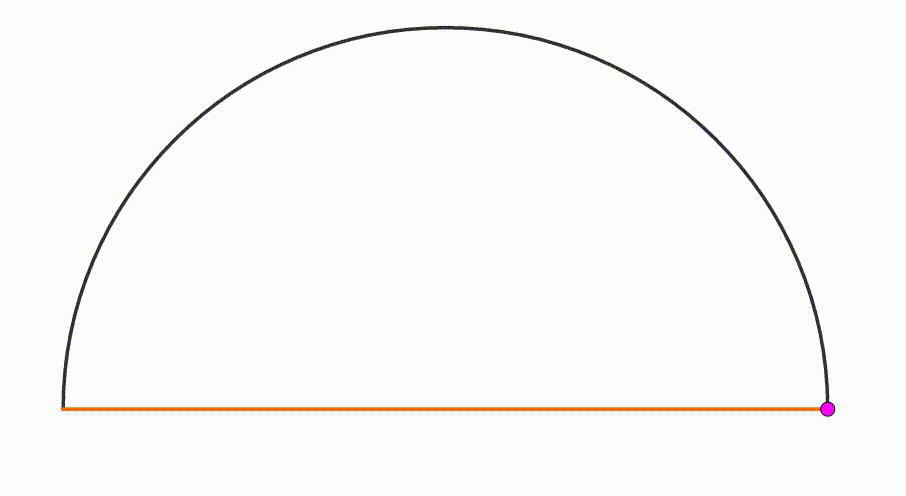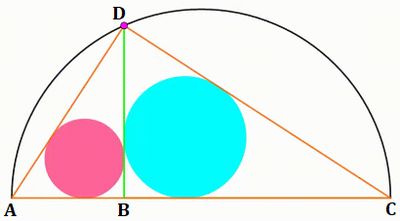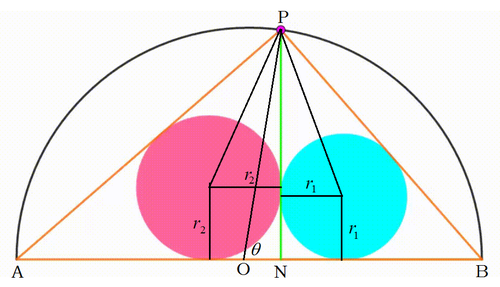Dynamic Geometry: P50
 The diagram shows a semicircle with radius
1
. A red point is moving along its arc. We use this point and the semicircle's diameter to draw an orange triangle. The green segment is the triangle's height and divides the orange triangle into two smaller triangles. We draw their respective incircles (pink and cyan). When the ratio of their radii is
2
1
2
0
, the sum of their radii can be expressed as
q
p
, where
p
and
q
are coprime positive integers. Find
p
+
q
.
The diagram shows a semicircle with radius
1
. A red point is moving along its arc. We use this point and the semicircle's diameter to draw an orange triangle. The green segment is the triangle's height and divides the orange triangle into two smaller triangles. We draw their respective incircles (pink and cyan). When the ratio of their radii is
2
1
2
0
, the sum of their radii can be expressed as
q
p
, where
p
and
q
are coprime positive integers. Find
p
+
q
.
The answer is 1333.
This section requires Javascript.
You are seeing this because something didn't load right. We suggest you, (a) try
refreshing the page, (b) enabling javascript if it is disabled on your browser and,
finally, (c)
loading the
non-javascript version of this page
. We're sorry about the hassle.
3 solutions
That one is not easy, well done !
Log in to reply
Thank you, I missed the similar triangles (though I have seen the idea multiple times) and just couldn't find enough equations/observations. Nice problem!
Label the diagram as follows:

By Thales's Theorem , ∠ A D C is a right angle, and since ∠ A B D and ∠ C B D are also right angles, ∠ A B D = 9 0 ° − ∠ A D B = ∠ B D C , so △ A D C ∼ △ A B D ∼ △ D B C by AA similarity.
Let a = A D and b = D C . By the Pythagorean Theorem on △ A D C , a 2 + b 2 = 4 .
When the ratio of the inradii of △ A B D and △ D B C is 2 1 2 0 , the ratio of the hypotenuses of △ A B D and △ D B C will also be 2 1 2 0 , so b a = 2 1 2 0 .
The two equations a 2 + b 2 = 4 and b a = 2 1 2 0 solve to a = A D = 2 9 4 0 and b = D C = 2 9 4 2 .
Since △ A B D ∼ △ A D C , A B = A D ⋅ A C A D = 2 9 4 0 ⋅ 2 2 9 4 0 = 8 4 1 8 0 0 and B D = A D ⋅ A C D C = 2 9 4 0 ⋅ 2 2 9 4 2 = 8 4 1 8 4 0 .
The inradius of △ A B D is then r 1 = 2 1 ( A B + B D − A D ) = 2 1 ( 8 4 1 8 0 0 + 8 4 1 8 4 0 − 2 9 4 0 ) = 8 4 1 2 4 0 .
And the inradius of △ B D C is then r 2 = 2 0 2 1 r 1 = 8 4 1 2 5 2 .
Which makes the sum of the two radii r 1 + r 2 = 8 4 1 2 4 0 + 8 4 1 2 5 2 = 8 4 1 4 9 2 , so p = 4 9 2 , q = 8 4 1 , and p + q = 1 3 3 3 .
Thank you for posting your solution David !
The half-angle tangent substitution makes it straight forward in solving incircle problems as illustrated in this solution.

Let the center of the semicircle be O , its diameter be A B , the red point on the arc be P , and the green segment be P N . Note that P N is perpendicular to A B . Let ∠ P O B = θ , then ∠ P A B = 2 θ . Due to similar triangles ∠ B P N = 2 θ . Let also the radius of the cyan circle be r 1 . Note that the line joining P and the center of the cyan circle bisect ∠ B P N . Therefore we have:
r 1 cot 4 θ + r 1 r 1 ⋅ t 1 + t = P N = P N Let t = tan 4 θ . . . ( 1 )
Similarly, let the radius of the pink circle be r 2 . Note that ∠ A P B = 9 0 ∘ . Then
r 2 cot ( 2 9 0 ∘ − 2 θ ) + r 2 r 2 cot ( 4 5 ∘ − 4 θ ) + r 2 r 2 ⋅ 1 − t 1 + t + r 2 r 2 ⋅ 1 − t 2 = P N = P N = P N = P N . . . ( 2 )
From ( 2 ) ( 1 ) :
r 2 ⋅ 1 − t 2 r 1 ⋅ t 1 + t 2 0 ⋅ t 1 + t 2 0 ( 1 − t 2 ) 1 0 t 2 + 2 1 t − 1 0 ( 5 t − 2 ) ( 2 t + 5 ) ⟹ t = P N P N = 1 = 2 1 ⋅ 1 − t 2 = 4 2 t = 0 = 0 = 5 2 Putting r 2 r 1 = 2 1 2 0 Since 4 θ is acute.
Note that P N = sin θ and that tan 2 θ = 1 − t 2 2 t = 2 1 2 0 , tan θ = 1 − ( 2 1 2 0 ) 2 2 ⋅ 2 1 2 0 = 4 1 8 4 0 ., and sin θ = 8 4 0 2 + 4 1 2 8 4 0 = 8 4 1 8 4 0 . Then from ( 2 ) ,
1 − t 2 r 2 ⟹ r 2 r 1 ⟹ r 1 + r 2 = P N = sin θ = 8 4 1 8 4 0 = 8 4 1 4 2 0 ( 1 − 5 2 ) = 8 4 1 2 5 2 = 2 1 2 0 r 2 = ( 2 1 2 0 + 1 ) r 2 = 2 1 4 1 ⋅ 8 4 1 2 5 2 = 8 4 1 4 9 2
Therefore p + q = 4 9 2 + 8 4 1 = 1 3 3 3 .
Clever approach ! Thanks for posting !
Therefore, p = 4 9 2 , q = 8 4 1 ⟹ p + q = 1 3 3 3